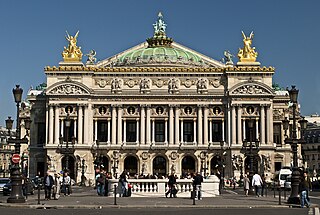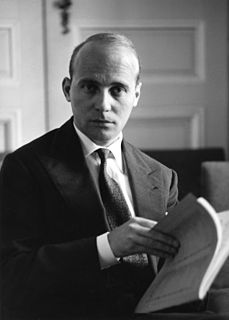Related Research Articles

Opera is a form of theatre in which music has a leading role and the parts are taken by singers, but is distinct from musical theater. Such a "work" is typically a collaboration between a composer and a librettist and incorporates a number of the performing arts, such as acting, scenery, costume, and sometimes dance or ballet. The performance is typically given in an opera house, accompanied by an orchestra or smaller musical ensemble, which since the early 19th century has been led by a conductor.

Christoph WillibaldGluck was a composer of Italian and French opera in the early classical period. Born in the Upper Palatinate and raised in Bohemia, both part of the Holy Roman Empire, he gained prominence at the Habsburg court at Vienna. There he brought about the practical reform of opera's dramaturgical practices for which many intellectuals had been campaigning. With a series of radical new works in the 1760s, among them Orfeo ed Euridice and Alceste, he broke the stranglehold that Metastasian opera seria had enjoyed for much of the century. Gluck introduced more drama by using simpler recitative and cutting the usually long da capo aria. His later operas have half the length of a typical baroque opera.

Jean-Philippe Rameau was one of the most important French composers and music theorists of the 18th century. He replaced Jean-Baptiste Lully as the dominant composer of French opera and is also considered the leading French composer for the harpsichord of his time, alongside François Couperin.
Orfeo ed Euridice is an opera composed by Christoph Willibald Gluck, based on the myth of Orpheus and set to a libretto by Ranieri de' Calzabigi. It belongs to the genre of the azione teatrale, meaning an opera on a mythological subject with choruses and dancing. The piece was first performed at the Burgtheater in Vienna on 5 October 1762, in the presence of Empress Maria Theresa. Orfeo ed Euridice is the first of Gluck's "reform" operas, in which he attempted to replace the abstruse plots and overly complex music of opera seria with a "noble simplicity" in both the music and the drama.
Iphigénie en Tauride is a 1779 opera by Christoph Willibald Gluck in four acts. It was his fifth opera for the French stage. The libretto was written by Nicolas-François Guillard.

Opera seria is an Italian musical term which refers to the noble and "serious" style of Italian opera that predominated in Europe from the 1710s to about 1770. The term itself was rarely used at the time and only attained common usage once opera seria was becoming unfashionable and beginning to be viewed as something of a historical genre. The popular rival to opera seria was opera buffa, the 'comic' opera that took its cue from the improvisatory commedia dell'arte.

Hans Werner Henze was a German composer. His large oeuvre of works is extremely varied in style, having been influenced by serialism, atonality, Stravinsky, Italian music, Arabic music and jazz, as well as traditional schools of German composition. In particular, his stage works reflect "his consistent cultivation of music for the theatre throughout his life".

Atalanta is a pastoral opera in three acts by George Frideric Handel composed in 1736. It is based upon the mythological female athlete, Atalanta, the libretto being derived from the book La Caccia in Etolia by Belisario Valeriani. The identity of the librettist is not known.

Acis and Galatea is a musical work by George Frideric Handel with an English text by John Gay. The work has been variously described as a serenata, a masque, a pastoral or pastoral opera, a "little opera", an entertainment and by the New Grove Dictionary of Music as an oratorio. The work was originally devised as a one-act masque which premiered in 1718.
Le cinesi is an opera in one act, with music composed by Christoph Willibald Gluck. The Italian-language libretto was by Pietro Metastasio, and he described it as a componimento drammatico. This libretto had first been set by Antonio Caldara in 1735. For Gluck's rework, the piece is often considered as an azione teatrale, even though Metastasio and the composer both retained the original designation. The work was first performed for the Austrian royal family at the Schloss Hof on 24 September 1754, on the occasion of the visit of the Empress Maria Theresa to the household of Saxe-Hildburghausen.

French opera is one of Europe's most important operatic traditions, containing works by composers of the stature of Rameau, Berlioz, Gounod, Bizet, Massenet, Debussy, Ravel, Poulenc and Messiaen. Many foreign-born composers have played a part in the French tradition as well, including Lully, Gluck, Salieri, Cherubini, Spontini, Meyerbeer, Rossini, Donizetti, Verdi and Offenbach.

Clori, Tirsi, e Fileno, Cantata a tre, HWV 96, subtitled Cor fedele in vano speri, is a 1707 comic cantata by George Frideric Handel. The subject is a pretty shepherdess who loves two young men, but loses both when they discover her fickleness. Believed lost for many years, the score is the source of arias in some of Handel's later, more celebrated operas.

La Dafne (Daphne) is an early Italian opera, written in 1608 by the Italian composer Marco da Gagliano from a libretto by Ottavio Rinuccini. It is described as a favola in musica composed in one act and a prologue. The opera is based on the myth of Daphne and Apollo as related by Ovid in the first book of the Metamorphoses. An earlier version of the libretto had been set to music in 1597–98 by Jacopo Peri, whose Dafne is generally considered to be the first opera.
Johann Christoph Vogel was a German composer.
Il ballo delle ingrate is a semi-dramatic ballet by the Italian composer Claudio Monteverdi set to a libretto by Ottavio Rinuccini. It was first performed in Mantua on Wednesday, 4 June 1608 as part of the wedding celebrations for Francesco Gonzaga and Margaret of Savoy. Both Vincenzo and Francesco Gonzaga took part in the dancing. Monteverdi also composed the opera L'Arianna and the music for the prologue to Guarini's play L'idropica for the occasion.
Il trionfo di Clelia is an 18th-century Italian opera in three acts by the Czech composer Josef Mysliveček composed to a libretto by the Italian poet Metastasio. It was common in the 1760s for composers to set Metastasian texts written decades before. Exceptionally, the text for Il trionfo di Clelia, first produced in Vienna in 1762, was almost new when Mysliveček was commissioned to compose his setting for Turin, and all of the aria texts used for his setting derive from the original libretto. This opera belong to the serious type in Italian language referred to as opera seria.
Ezio is a baroque opera in three acts composed by Christoph Willibald Gluck, staged in 1750 and revised in 1763.
Antigono is a three act opera seria composed by Christoph Willibald Gluck. It premiered February 9, 1756, at the Teatro di Torre Argentina in Rome, Italy. The Italian libretto was written by Pietro Metastasio, who was considered to be the most important opera seria librettist. Antigono was the only opera that Gluck ever premiered in Rome. This allowed him to reuse several arias and an entire introduction from some of his other operas, L’innocenza Giustificata, L’cinesi, and La Danza.

Giovanni Ambrogio Migliavacca was an Italian poet and librettist. A student and protégé of Metastasio, he was primarily active in the court theaters of Dresden and Vienna. His most successful work was the libretto for the opera Solimano, first set by Johann Adolph Hasse in 1753 and subsequently set by 18 other composers in the course of the next 50 years.
References
- ↑ Article by Julian Rushton in The Viking Opera Guide, ed. Amanda Holden (Viking, 1993), p. 372.
- 1 2 La danza, in Gluck Gesamtausgabe, Akademie der Wissenschaften und der Literatur, Mainz